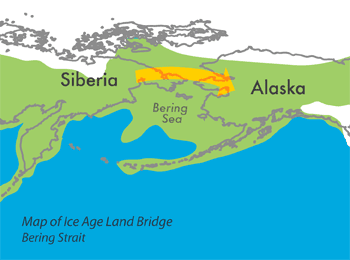 Just when you thought everything was starting to make sense — new genetic research on the peopling of the Americas throws us a curve.
Just when you thought everything was starting to make sense — new genetic research on the peopling of the Americas throws us a curve.
There has been plenty of research in both genetics and archaeology recently trying to figure out how the New World was colonized.
Was it by boat or via the frozen wasteland of the Bering Strait? Was it a fast trip down to South America, or did these first inhabitants take a more leisurely stroll? And when did all this happen anyway?
New Evidence
As each new study is published we are learning vital information on the peopling of the Americas. Ideas and theories continue to be retooled as new evidence comes to light.
This will certainly be the case with regards to a paper in the May 2008 issue of PLoS Genetics. In this article, researchers from Oxford and Cornell Universities report on a new computer model they have developed to trace prehistoric human migrations across the globe.
Using genetic information from various populations alive today, the authors estimated how those groups may be related to one another. Then they used those relationships to piece together the prehistoric movements of early humans.
The First Americans
As expected, their analysis showed a single migration out of Africa that eventually populated Eurasia and the Americas. However, the results for the Peopling of the Americas were more surprising.
The conventional wisdom states that the first inhabitants of the Americas came from Asia in a single wave more than 10,000 years ago. But when the authors compared the genetic data of two Native American groups (one in Colombia and one in the American Southwest) to groups in East Asia, what they found supported a two-wave migration.
The Colombian sample of Native Americans was actually more closely related to the East Asian sample than it was to the American Southwest sample. That suggests the two populations come from independent sources — and that there were at least two separate migrations of humans into the New World. Clearly, one of these migrations would have come from East Asia and made its way into South America. However, the data suggest a separate migration, probably from a different part of Asia or Siberia, came at a different time, and this time only made it to North America. This conclusion is significant, as it contradicts current theories on the topic, which argue a more constant flow of migrants from an original source somewhere in Asia.
There are still plenty of questions regarding this research, especially with regard to how it compares to the archaeological record and to previous genetic studies. The answers to these questions can only come with additional research, which, thankfully, is always forthcoming on the peopling of the Americas.



